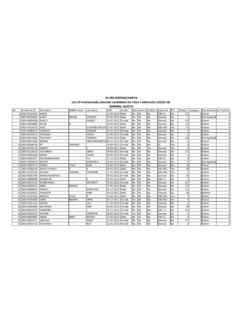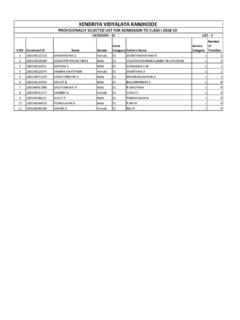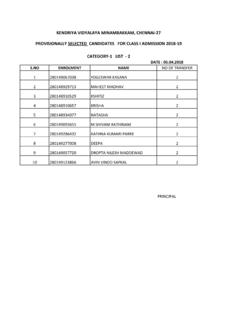Transcription of Workplace fatal injuries in Great Britain 2018 - …
1 This document is available from Page 1 of 16 Health and Safety Executive fatal injuries arising from accidents at work in Great Britain 2017 Headline results Contents Summary 2 Introduction 3 fatal injuries to workers 3 Headline figures 3 injuries by industry 4 injuries by accident kind 6 injuries by gender and age 7 injuries by employment status 8 injuries by country and region within GB 9 Injury comparison with other countries 10 Longer term trends 11 fatal injuries to members of the public 12 Technical note 13 Annex 1 Industry definitions 15 This document is available from Page 2 of 16 Summary The document can be found at: 137 Workers killed at work in 2016/17 fatal injuries to workers by main industry fatal injuries to workers by age Main kinds of fatal accident for workers Rate of fatal injury per 100,000 workers 92 Members of the public were killed due to work related activities in 2016/17 This document is available from Page 3 of 16 Introduction This report provides headline numbers on Workplace fatal injuries that were reported to enforcing authorities in 2016/17.
2 It includes both fatal injuries to workers and to members of the public. The 2016/17 figures are currently provisional, and marked as p and will be finalised in July 2018 to take account of any necessary adjustments. fatal injuries are thankfully rare events. There is a degree of chance and randomness to the annual count resulting in an element of natural variation from one year s count to the next. To allow for this natural variation, alongside figures for 2016/17, this report also presents the annual average estimate for the five years 2012/13-2016/17, which reduces the effect of year-on-year fluctuations and gives a more stable current picture. The figures make up part of a long running series enabling both short and long term comparisons of change.
3 The information includes only those cases of fatal injury that the enforcing authorities have judged as meeting the reporting criteria as set out in the Reporting of injuries , Diseases and Dangerous Occurrences Regulations (RIDDOR). Two notable exclusions from these statistics are fatal diseases and fatal accidents on non-rail transport systems. (See Technical note for more details). fatal injuries to workers Headline figures A total of 137 workers were killed at work in Great Britain in 2016/17p. Although this represents a reduction of 10 fatalities from 2015/16, it is possible that this change can be explained by natural variation in the figures. It is the second lowest year on record after 2013/14. However, in statistical terms the number of fatalities has remained broadly level in recent years the average annual number of workers killed at work over the five years 2012/13-2016/17p is 142.
4 Figure 1: fatal injuries to workers: GB 2006/07 - 2016/17p This document is available from Page 4 of 16 injuries by industry1 There are two ways of looking at fatality numbers. The first is to look at the absolute count. On this basis, construction and agriculture tend to come out worst as they account for the greatest number of fatalities each year. Figure 2: Number of fatal injuries by main industry group, 2016/17p and annual average for 2012/13-2016/17p The number of fatalities in construction in 2016/17p (30) is the lowest number on record for the sector. However, over the last five years the number has fluctuated, with 47 fatalities in 2015/16 compared with 35 in 2014/15. The annual average for the past five years is 39.
5 The number of fatal injuries in waste and recycling in 2016/17p (14) is almost double the annual average for the past five years (8) and compares with 6 deaths in 2015/16. While fatal numbers for the sector have fluctuated in recent years, this increase in the current year is largely explained by a single incident which resulted in 5 deaths in 2016/17. The 21 fatal injury cases in Other sectors in 2016/17 include cases in o Communication, Business Services and finance (8 fatalities); o Public administration; education; human health and social work activities (6 fatalities); o Mining and quarrying (4 fatalities); o Electricity, Gas, Steam and Air Conditioning (3 fatalities). 1 Industry is defined using the 2007 Standard Industrial Classification.
6 See annex 1 for more details. This document is available from Page 5 of 16 The second approach of looking at fatality numbers is to consider the fatal injury rate in terms of the number of fatalities per 100,000 workers employed. Figure 3: Rate of fatal injuries by selected main industry group, 2016/17p and annual average for 2012/13-2016/17p Based on the annual average rates for 2012/13-2016/17p (as this reduces the effect of year-on-year fluctuations and gives a more stable picture): Agriculture and Waste and recycling come out worst, with a rate of injury some 18 times and 15 times higher than the average across all industries respectively. The rate of fatal injury in Construction, while around 4 times higher than the rate across all industries, is considerably less than the rate in either agriculture or waste and recycling, despite accounting for a greater number of cases than these sectors.
7 In both the manufacturing sector and the transportation and storage sector the fatal injury rate is around twice the all industry rate. Although not shown in figure 3 above, the rate of fatal injury in mining and quarrying is around 4 times greater than the all industry rate and similar to that seen in construction. While the combined Wholesale/retail trade; vehicle repair; accommodation and food services sector account for around 7% of fatal injuries , in terms of rate the sector is relatively low risk with an injury rate less than half the all industry rate. For more details of fatal injuries by main industry sector, see Table 1, This document is available from Page 6 of 16 injuries by accident kind Around three-quarters of fatal injuries in both 2016/17p and the combined five year period 2012/13-2016/17p were accounted for by just 6 different accident kinds.
8 Being struck by moving vehicles, falls from a height and being struck by a moving, including flying or falling, object continue as the three main causes of fatal injury, between them accounting for over half of all fatal injuries each year since at least 2001/02. Figure 4: Number of fatal injuries to workers by accident kind, 2016/17p and annual average for 2012/13-2016/17p In 2016/17p, 25 fatal injuries to workers were due to falls from a height. This is the lowest number on record and compares to 37 in 2015/16 and an annual average over the period 2012/13-2016/17p of 40. It is possible that the sharp drop in the most recent year can be explained by natural variation in the figures. Being struck by a moving vehicle accounted for 31 fatal injuries to workers in 2016/17p compared with 28 in 2015/16 and an annual average of 25 over the period 2012/13-2016/17p.
9 The number of fatal injuries caused by being struck by a moving, including flying or falling, object has fluctuated between 14 and 20 in each of the last five years, with an annual average of 17 over the period 2012/13-2016/17. For more details of fatal injuries by accident kind, see Table 3, This document is available from Page 7 of 16 injuries by gender and age fatal injuries to workers are predominately to male workers. In 2016/17, 133 (97%) of all worker fatalities were to male workers, a similar proportion to earlier years. In terms of age, around a quarter of fatal injuries in both 2016/17p and the combined five year period 2012/13-2016/17p were to workers aged 60 and over, even though such workers made up only around 10% of the workforce.
10 Figure 5: Number of fatal injuries by age group, 2016/17p Figure 6 below shows the fatal injury rate by age group for the period 2012/13-2016/17p. This clearly shows how the rate of fatal injury increases with age, with workers aged 60-64 having a rate almost double the all ages rate, and workers aged 65 and over a rate around four times greater than the all ages rate. While this age gradient in rate is most strongly seen in agriculture, it is also present across a range of other sectors too. See and table 4 for more details. Figure 6: Rate of fatal injuries by age group, annual average for 2012/13-2016/17p This document is available from Page 8 of 16 injuries by employment status Over a quarter of fatal injuries in both 2016/17p and the five year-period 2012/13-2016/17p, were to self-employed workers, working mostly in agriculture and construction but also in other sectors including manufacturing, the wholesale/retail trade; vehicle repair; accommodation and food services sector and administrative and support service activities (such as renting and leasing activities and services to buildings and landscape activities).














